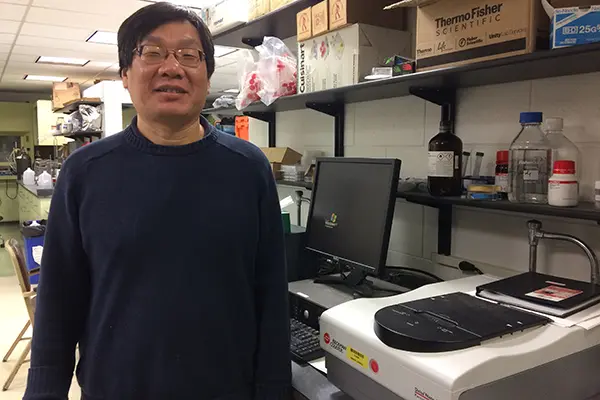Cleaner Dyes Could Bring Manufacturing Jobs Back to U.S.
 Image by Katharine Webster
Image by Katharine Webster
01/31/2017
By Katharine Webster
Chemistry Prof. Yuyu Sun has won a three-year, $490,000 grant from the Walmart Foundation to develop cleaner technology for dyeing fabrics.
The grant is one of just six awarded by the foundation this year through the Walmart U.S. Manufacturing Innovation Fund, which supports research that could lower the cost of manufacturing products in the United States. All of this year’s grants involve ways to make textile production more efficient and environmentally sustainable.
The grant will help Sun further investigate the use of nanotechnology to develop more environmentally friendly dyes. Sun says he welcomes the support, which will allow him to involve more graduate students in his research.
“This is a good opportunity to help students apply what they have learned in their courses and to solve real-world problems,” he says.
In traditional textile manufacturing, fabric is immersed in a solution containing dye; while some of the dye bonds with the fabric, much of it remains in the solution and subsequent rinses, and it’s difficult to remove from the wastewater stream.
Sun is using nanotechnology to modify common types of dyes so their motion can be controlled with magnetic fields. The idea is that manufacturers can use magnets to pull the modified dyes into the fabrics more efficiently — and then remove most of the remaining dye from the wastewater.
Sun has already had preliminary success with two of the most commonly used classes of dyes—dispersed dyes, used on polyester fabrics, and reactive dyes, used for cotton. He has a patent pending on the technology.
During the 1800s, when Lowell was the leading center for the thriving U.S. textile industry, the mills discharged millions of gallons of bleach and dye into the Merrimack and Concord rivers. Most of Lowell’s mills had closed by the mid-1900s, as the industry moved to the cotton-growing South. Passage of the 1972 Clean Water Act, which strictly controlled wastewater discharges, eventually sent most textile factories to other countries where it was cheaper to do business because of lax environmental laws.
Sun, whose past research has yielded anti-microbial fabrics, paints, dental tubing and dentures, hopes to reverse that trend by developing safer, cleaner and more cost-effective dyes. He’s part of a long tradition at UMass Lowell that originated with the Lowell Textile School, which was founded in 1895 to train technicians, managers and engineers for the city’s textile industry.
“As professors, we not only need to do research and teach, but serve the society at large,” he says. “This product will provide a really good opportunity to train students. Also, if we are successful, this technology will make a contribution to reducing pollution and improving the economy, so it’s something I’m happy to do and really motivated to do.”




